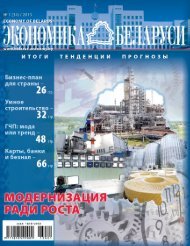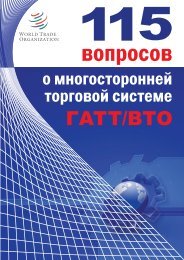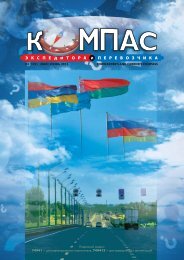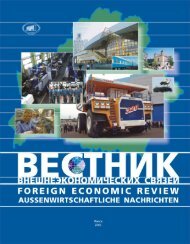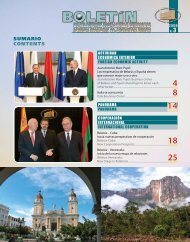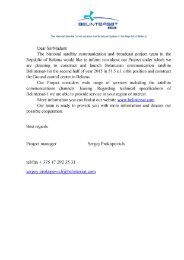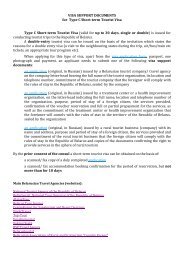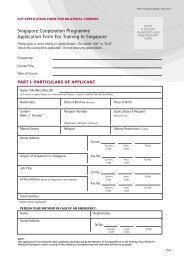BOX 5.2Jo Leinen, Member of the European ParliamentA world parliament for global democracy?Legitimacy and representativeness of the world’s people in global decisionmakingare imperative for the governance of global issues, but globaldecisionmaking bodies have no institutional mechanisms for effective andinfluential citizen participation. At a time when intergovernmental decisionmakinghas shown its limits, the quest for equity and sustainability and theurgency of addressing defining challenges for our planet require the engagementof the global citizenship.A world parliament would complement the United Nations GeneralAssembly—either formally integrated in the UN system or instituted as aseparate body. This idea is not new, but as it matures, it is receiving increasingsupport from civil society actors and regional parliaments (including theEuropean, Latin American and African Parliaments) and was recently highlightedin the Manifesto for Global Democracy put forward by a multinationalgroup of intellectuals. 1A world parliament would be composed of delegates from national parliaments,representing multiple political parties from each country. Sincethe great majority of national parliaments are democratically elected, sucha body would have a high level of representativeness and political accountability.A world parliament would serve as a link between nationalpolicymaking and global decisionmaking, providing incentives for nationalparliaments and governments to consider the implications of decisions beyondnational borders and instilling national parliaments with knowledgeand experience on governing global issues.This assembly could have one extended annual session, during whichit would issue recommendations and add agenda items to the UN GeneralAssembly and, by a qualified majority, submit agenda items to the UNSecurity Council for debate and decisions. The deliberations would possessa high moral and political authority, although the final decisionmaking powerwould remain with national governments. The composition of each nationaldelegation could be determined either by national parliaments or throughspecial elections allowing citizens to choose representatives for the worldparliament. Delegation size would be proportional to a country’s population,an approach considerably different from international bodies where votingquotas are based on monetary contributions.1. Beeston 2012.The challenge facingthe multilateral systemis not a false choicebetween older structuresdevised by the North andnewer arrangementsresponding to theneeds of the developingworld. It is integrating,coordinating and insome cases reformingthese institutions sothat they can work moreeffectively togetherinternational governance. The World HealthOrganization, for example, has had to managestate interests carefully and adjust to theemphasis on privatizing health services thatbecame dominant in the 1980s. Its core commitmentsto public health and its ties to civilsociety, however, have enabled it to continue topursue policies that emphasize a rights-basedapproach to health. 30Towards coherent pluralismThe challenge facing the multilateral system inresponse to the rise of the South is not a falsechoice between globalism and regionalism orbetween older structures devised and managedby the traditional powers of the North andnewer arrangements responding to the needs ofthe developing world. Rather, it is integrating,coordinating and in some cases reforming theseinstitutions so that they can all work moreeffectively together. Diversity and flexibility inglobal governance mechanisms can be net positivesfor the international system but cannotsubstitute for the global pursuit of solutions toproblems that are inherently global in nature.Policymakers working both regionally andinternationally should strive towards a morecoherent pluralism in multilateral governance,with shared norms and goals supporting variedyet complementary regional and global developmentinitiatives.Recent experience in much of the Southhas shown that some public goods can beeffectively provided at the regional level. Asnoted in chapter 2, regional institutions cansometimes respond to regional needs faster andmore efficiently than can global forums—forexample, programmes for eradicating endemicdiseases, protecting shared ecosystems andremoving barriers to intraregional commerce.In such cases, it makes sense for like-mindedneighbouring states to address these challengescooperatively while pursuing global responsesto these issues where needed.Increasing regional cooperation can also havedisadvantages—adding further complexity toan already diverse array of multilateral institutions,with all the attendant risks of exclusion,duplication and interagency competition. Inmany areas, regional institutions have the potentialto complement global structures, evenif that kind of coordination seems rare or inadequatelysynchronized today.Global governance arrangements mustrespect the mixed strategies that countriesare choosing. It is clear that developing andemerging economies are choosing to cooperatein different ways—bilaterally, regionally112 | HUMAN DEVELOPMENT REPORT <strong>2013</strong>
and internationally. Over time, as new setsof challenges have emerged, countries havecreated new forms of governance to deal withthese. In finance, for example, countries wantto diversify their exposure and their “insurancepolicies”. They seek to use a mixture of nationalreserves, bilateral credit lines, regional arrangementsand the IMF. The international regimeneeds to be pluralist while ensuring that cooperationat the regional and subregional levelsis consistent with mechanisms and policies atthe international level.The ultimate purpose of this “coherentpluralism” is to ensure that institutions at alllevels work in a coordinated fashion to provideglobal public goods. The complementarity notjust between global and regional institutions,but also across public, private and civil societyorganizations, has the potential to be constructive,even if it may appear fledgling and inadequateat present. Where new arrangementsand new partnerships arise to meet the gapsleft by old arrangements, they should be encouraged,avoiding duplication to the greatestextent possible. New arrangements at all levelsmust work in concert with each other and instep with existing multilateral organizations,aligning interests and sharing responsibilities.While pluralism and greater diversity arewelcome developments, duplication and inefficiencyoccur among the plethora of new organizations.Moving towards a coherent structure,some organizations will survive, and others willbe deemed redundant.The governance of global public goods forsustained progress in human development requireseffective multilateralism. Internationalinstitutions can also provide guidance on humanrights and other universal principles andarbitrate in such areas as public internationallaw. However, multilateralism will need to bemore flexible to deal with new challenges andgeopolitical realities. In a coherent pluralisticsystem, international institutions can serve ascoordinating bodies, playing a catalytic or conveningrole for all stakeholders. To do this, theyneed the mandate and sufficient expertise andresources to mediate and facilitate, to analyseand respond to often divergent interests andto propose workable and mutually beneficialoutcomes. To fully engage the South, manyinternational organizations need updatingand transforming. The South in turn is morelikely to use and fully support multilateral institutionsthat are seen to be acting as much inthe interests of the South as in the interests ofdeveloped countries.Financial architecture: redesignfor the rising SouthThe rise of the South is creating new patterns ofresource accumulation, potentially leading to adenser, multilayered and more heterogeneousfinancial architecture. This could promote financialstability and resilience, support long-runproductive capacities, advance human developmentand enlarge national policy space.In some cases, these emerging institutionsand arrangements could substitute for someof the functions of the Bretton Woods institutions,but in most cases, they complement theexisting global financial architecture. Moreover,emerging institutions may prove transformativeby prodding the Bretton Woods institutions torespond to concerns about representation, governanceprinciples and conditionalities.The South has already developed several alternativeinstitutions and approaches, includingregional monetary and support arrangements:• The Chiang Mai Initiative emerged in thewake of the 1997 Asian financial crisis, takingthe form of a series of swap arrangementsamong Asian countries. It evolved into theChiang Mai Initiative Multilateralization,which allows members to draw on themultilateral swap facility to address balanceof payments and short-term liquiditydifficulties.• The Arab Monetary Fund, founded in 1976by the 22 member countries of the League ofArab States, has some $2.7 billion to supportemergency financing for member countriesas well as broader monetary cooperation.There is also an aspiration for a unified Arabcurrency. 31• The Reserve Bank of India recently announceda $2 billion swap facility formembers of the South Asian Association forRegional Cooperation. 32• The Latin American Reserve Fund, with acapitalization of about $2.3 billion, offersbalance of payments support to members.It also guarantees third-party loans andThe ultimate purposeof “coherent pluralism”is to ensure thatinstitutions at all levelswork in a coordinatedfashion to provideglobal public goodsChapter 5 Governance and partnerships for a new era | 113
- Page 1 and 2:
WNSEHuman DevelopmentReport 2013The
- Page 3 and 4:
Human Development Report 2013The Ri
- Page 5 and 6:
Human Development Report 2013 TeamD
- Page 7 and 8:
Finally, the Report also calls for
- Page 9 and 10:
Heather Simpson, Ben Slay, Mounir T
- Page 11 and 12:
3.6 India’s Supreme Court issues
- Page 13 and 14:
OverviewOne of the most heartening
- Page 15 and 16:
and sustainability are fully incorp
- Page 17 and 18:
Without investment in people, retur
- Page 19 and 20:
opportunity to reap the full benefi
- Page 21 and 22:
Woods institutions, the United Nati
- Page 23 and 24:
IntroductionWhen developed economie
- Page 25 and 26:
leading economies—Brazil, China a
- Page 27 and 28:
comparable access to information, e
- Page 29 and 30:
mobile phones: cellular banking is
- Page 32 and 33:
“The political problem ofmankind
- Page 34 and 35:
BOX 1.1Fairness, macroeconomics and
- Page 36 and 37:
BOX 1.3Amartya Sen, Nobel Laureate
- Page 38 and 39:
FIGURE 1.1Income per capita is risi
- Page 40 and 41:
BOX 1.4Subjective indicators of wel
- Page 42 and 43:
FIGURE 1.4There is notable variatio
- Page 44 and 45:
FIGURE 1.6Most regions show declini
- Page 46 and 47:
Progress in humandevelopment achiev
- Page 48 and 49:
BOX 1.7Social competencies: human d
- Page 50 and 51:
TABLE 1.3Inequality and satisfactio
- Page 52 and 53:
Not all countries havethe precondit
- Page 54 and 55:
“When the music changes,so does t
- Page 56 and 57:
BOX 2.1The South’s integration wi
- Page 58 and 59:
FIGURE 2.1As a share of world merch
- Page 60 and 61:
BOX 2.2Acquisitions by the South of
- Page 62 and 63:
FIGURE 2.3Between 2000 and 2010, In
- Page 64 and 65:
FIGURE 2.4Export earnings per capit
- Page 66 and 67:
BOX 2.6Final assembly is about more
- Page 68 and 69:
Instead of having a centreof indust
- Page 70 and 71:
FIGURE 2.6Emerging market economies
- Page 72 and 73:
Developing countriestrade more amon
- Page 74 and 75: “We cannot expect thatall nations
- Page 76 and 77: TABLE 3.1Selected developing countr
- Page 78 and 79: A common featureof countries thatha
- Page 80 and 81: More important thangetting prices r
- Page 82 and 83: BOX 3.5Eastern Europe and Central A
- Page 84 and 85: States have to beconscious that the
- Page 86 and 87: As countries develop,they tend to d
- Page 88 and 89: Having weathered theAsian financial
- Page 90 and 91: Providing publicservices that contr
- Page 92 and 93: Advancing health requiresmore than
- Page 94 and 95: Universal public healthand educatio
- Page 96 and 97: • China. The Minimum Livelihood G
- Page 98 and 99: “Each generation will reap whatth
- Page 100 and 101: concerns will make for a complex en
- Page 102 and 103: A greater emphasison education cans
- Page 104 and 105: FIGURE 4.1Under the fast track scen
- Page 106 and 107: Around the worldpeople are calling
- Page 108 and 109: FIGURE 4.4Different environmental s
- Page 110 and 111: FIGURE 4.5Education policies can al
- Page 112 and 113: BOX 4.2China and Ghana: who benefit
- Page 114 and 115: FIGURE 4.8countries thus converge t
- Page 116 and 117: “Let us join hands to try tocreat
- Page 118 and 119: Areas of globalinternational concer
- Page 120 and 121: Addressing climatechange requires t
- Page 122 and 123: International governanceis increasi
- Page 126 and 127: facilitates reserve investments and
- Page 128 and 129: Responsible sovereigntytakes the lo
- Page 130 and 131: FIGURE 5.1Under the accelerated pro
- Page 132 and 133: Good policymakingrequires greater f
- Page 134 and 135: A fair and less unequalworld requir
- Page 137 and 138: NotesOverview1 Atsmon and others 20
- Page 139 and 140: 25 Blinder 2006.26 UNIDO 2009.27 UN
- Page 141 and 142: which is 61.7 deaths per 1,000 live
- Page 143 and 144: ReferencesAbdurazakov, A., A. Minsa
- Page 145 and 146: urban_world_cities_and_the_rise_of_
- Page 147 and 148: Kamau, P., D. McCormick, and N. Pin
- Page 149 and 150: Labor Administration. Geneva: Inter
- Page 151 and 152: Human Development Report 2013The Ri
- Page 153 and 154: Statistical acknowledgementsThe Rep
- Page 155 and 156: Key to HDI countries and ranks, 201
- Page 157 and 158: Human Development Report 2013The Ri
- Page 159 and 160: Human Development Report 2013The Ri
- Page 161 and 162: Human Development Report 2013The Ri
- Page 163 and 164: Human Development Report 2013The Ri
- Page 165 and 166: Human Development Report 2013The Ri
- Page 167 and 168: Human Development Report 2013The Ri
- Page 169 and 170: Human Development Report 2013The Ri
- Page 171 and 172: Human Development Report 2013The Ri
- Page 173 and 174: Human Development Report 2013The Ri
- Page 175 and 176:
Human Development Report 2013The Ri
- Page 177 and 178:
Human Development Report 2013The Ri
- Page 179 and 180:
Human Development Report 2013The Ri
- Page 181 and 182:
Human Development Report 2013The Ri
- Page 183 and 184:
Human Development Report 2013The Ri
- Page 185 and 186:
Human Development Report 2013The Ri
- Page 187 and 188:
Human Development Report 2013The Ri
- Page 189 and 190:
Human Development Report 2013The Ri
- Page 191 and 192:
Human Development Report 2013The Ri
- Page 193 and 194:
Human Development Report 2013The Ri
- Page 195 and 196:
Human Development Report 2013The Ri
- Page 197 and 198:
Human Development Report 2013The Ri
- Page 199 and 200:
Human Development Report 2013The Ri
- Page 201 and 202:
Human Development Report 2013The Ri
- Page 203 and 204:
Human Development Report 2013The Ri
- Page 205 and 206:
Human Development Report 2013The Ri
- Page 207 and 208:
Human Development Report 2013The Ri
- Page 209 and 210:
Human Development Report 2013The Ri
- Page 211 and 212:
Statistical referencesADB (Asian De
- Page 213 and 214:
Core features of the model pertinen
- Page 215 and 216:
Countries and HDI ranks in 2012 and



